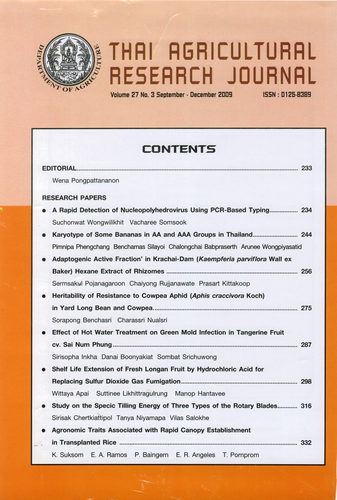A rapid Detection of Nucleopolyhedrovirus Using PCR-Based Typing
DOI:
https://doi.org/10.14456/thaidoa-agres.2009.16Keywords:
nucleopolyhedrovirus, NPV, Helicoverpa armigera, Spodoptera exigua, spodoptera litura, Trichoplusia ni, cathepsin gene , identification, PCR based-typingAbstract
Research on a rapid detection and identification of nucleopolyhedrovirus using PCR-based typing. The experiment was conducted at the Biocontrol Laboratory, Plant Protection Research and Development Office, Department of Agriculture, Department of General Science, Kasetsart University during October 2006- September 2008. Thai strains of four nucleopolyhedrovirus (NPV) pathogens namely Helicoverpa armigera single-nucleocapsid NPV (HaSNPV), Spodoptera exigua multiple-nucleocapsid NPV (SeMNPV), S. litura multiple -nucleocapsid NPV (SIMNPV) and Trichoplusia ni multiple-nucleocapsid NPV (TnMNPV) were detected and identified, Using PCR based-typing well done by designing degenerate primers from cathepsin gene. The cathepsin forward and reverse primers were 5´-TT(AC)G AA(G)A GTC AA(G)T ATG CC(T)A T-3´ and 5´-TAG CA(GC)G TCG AC(T)G CCC A(G)TG(C) G-3´. DNA fragments of polymorphism were successfully amplified and showed base pairs of 350 and 300 bp for HaSNPV, 400 bp for SeMNPV, 550 and 250 bp for SIMNPV and only 100 bp for TnMNPV. These designated primers could be used for rapid detection of four NPV which took only 16 hours compared to the total of 15 days required by host larvae process.
Downloads
Published
How to Cite
Issue
Section
License
Copyright (c) 2017 วารสารวิชาการเกษตร (Thai Agricultural Research Journal)

This work is licensed under a Creative Commons Attribution-NonCommercial-NoDerivatives 4.0 International License.
Thai Agricultural Research Journal


